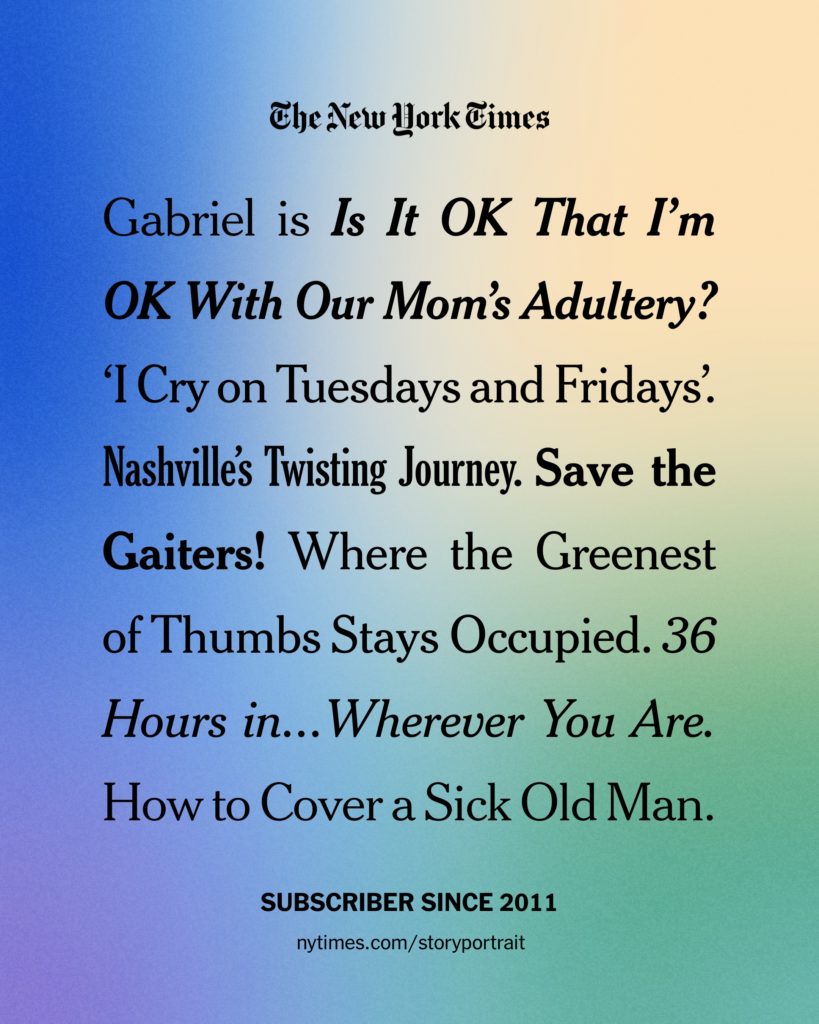At The New York Times, News Reads You!
In the summer of 1959, when the artist Brion Gysin started cutting up newspapers to make poetic collages, he likely didn’t imagine the New York Times marketing department echoing his cut-up technique 63 years later. When subscribers started seeing the option to see their “Story Portrait” on the footers of Times web pages as part of a project launched in June, however, they found something quite similar. The interactive spits out headlines of stories the subscriber has read arranged in a poetic jumble over colors to indicate which sections they most engaged with. The Times didn’t entirely adhere to the principle of scrambled randomness that instilled Gysin’s cut-ups with their spontaneous magic — an explainer notes, “The New York Times will not include excessively grim headlines in your Story Portrait” — but the process by which The Times’s algorithms put together data about readers is sufficiently mysterious to achieve a similar effect.

“Story Portrait analyzes each subscriber’s unique reading habits to serve them a snapshot of themselves through their interactions with The Times,” said Times spokesperson Elizabeth MacAulay. “Multiple algorithms were created for the process, as well as a custom API that lets Story Portrait draw on a selection of 50,000-plus Times articles from the last two years.” Gysin’s friend William Burroughs argued that the cut-ups had as much to say as the originals, if not more. That’s not quite true of The Times’s automated cut-ups. “We did filter out some headlines that included names or trademarks or conjured up excessively grim imagery for this type of experience,” MacAulay said.
So it doesn’t reflect the whole of the report, but does it reflect the reader? Scanning the lines can leave a subscriber pondering what the algorithms are trying to say about them, especially when headlines are borrowed from “The Ethicist” column. Perhaps those twinges of discomfort are why we’ve yet to see the portraits circulating as widely as similar gimmicks, like Spotify Wrapped, where corporations make a show of force, in a mostly benign form, of all the data they’ve collected about the users of their services.
While many of the paper’s recent marketing efforts have focused on showing how The Times conducts its reporting and why readers might consider trusting them, the Story Portraits are in line with another long-established strategy. “Our readers must become a bigger part of our report,” the report of the paper’s 2020 group, which was supposed to outline “the newsrooms’ strategy and aspirations,” recommended in 2017. “Network effects are the growth engine of every successful startup, Facebook being the prime example. But the Times experience doesn’t get more interesting or valuable as more of a reader’s friends, relatives and colleagues use it. That must change.”
Executive editor Joe Kahn has noted that The Times’s Live formats are, in part, an attempt to capture some of the reportorial energy that sites like Twitter had previously aggregated. Story Portraits are another way the paper is emulating its social media competitors. While editors still curate the paper’s news feed, these algorithmic creations are the organization’s way of saying The Times tries to read its readers as, if not more, closely as they read The Times.
